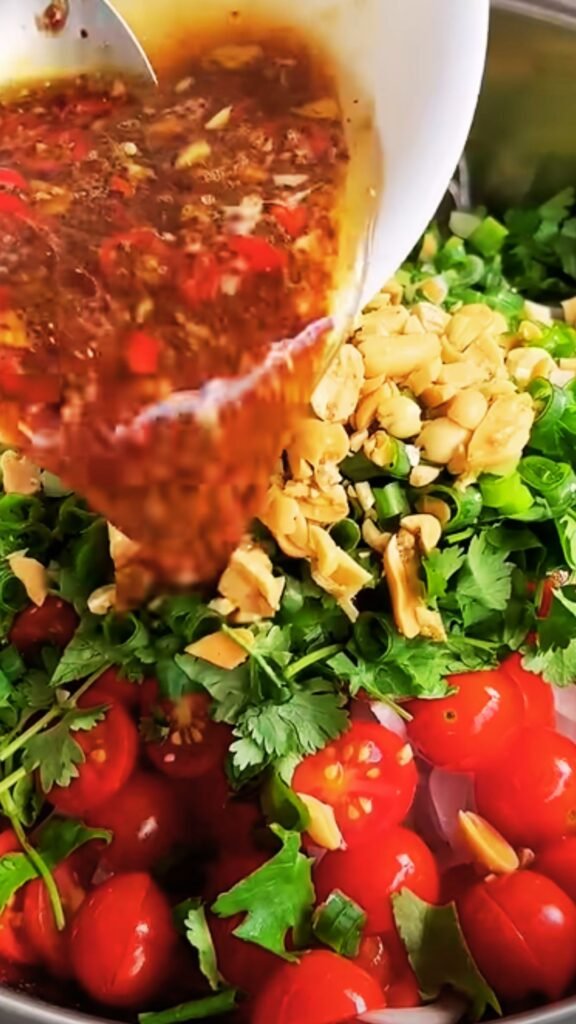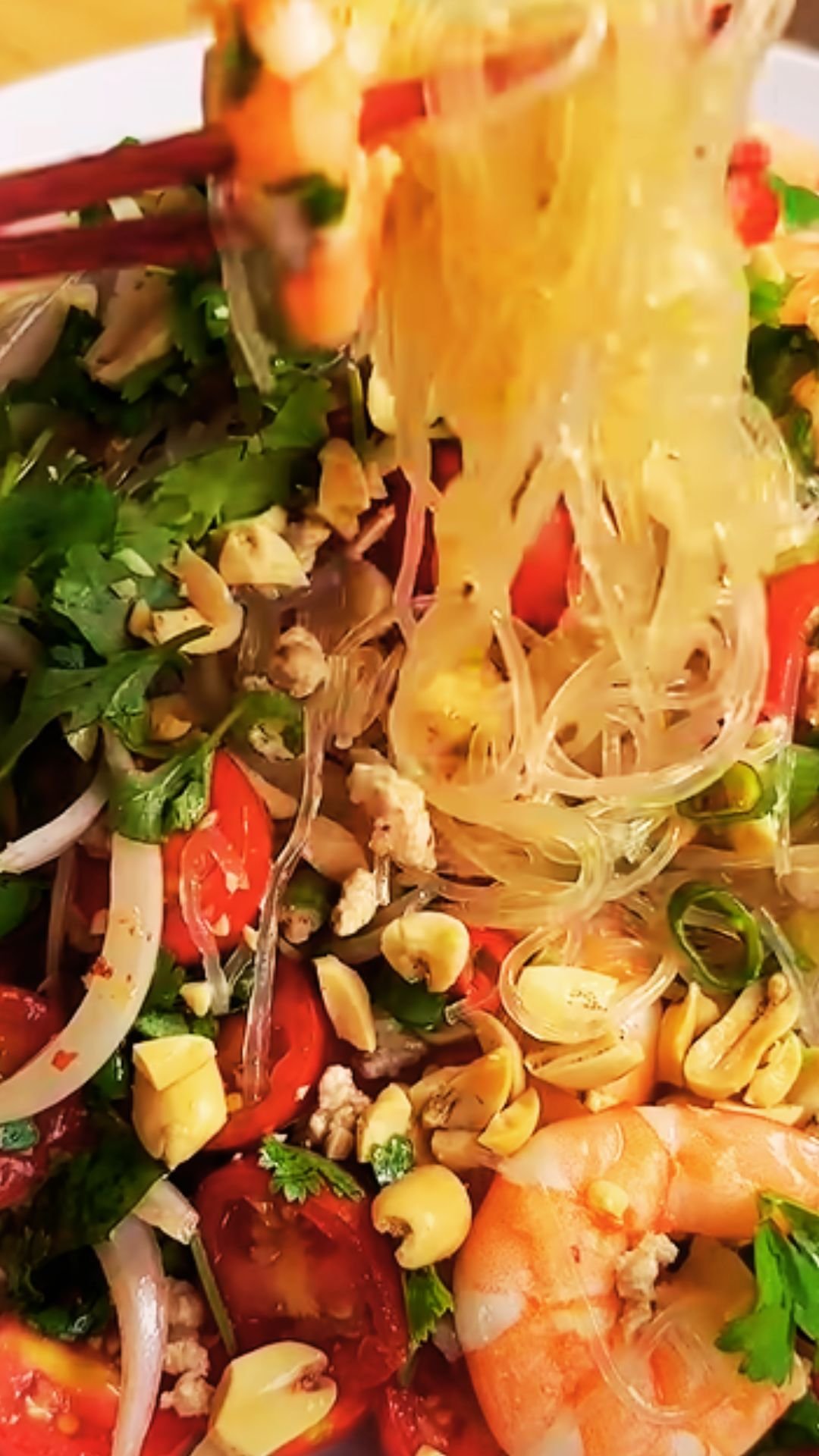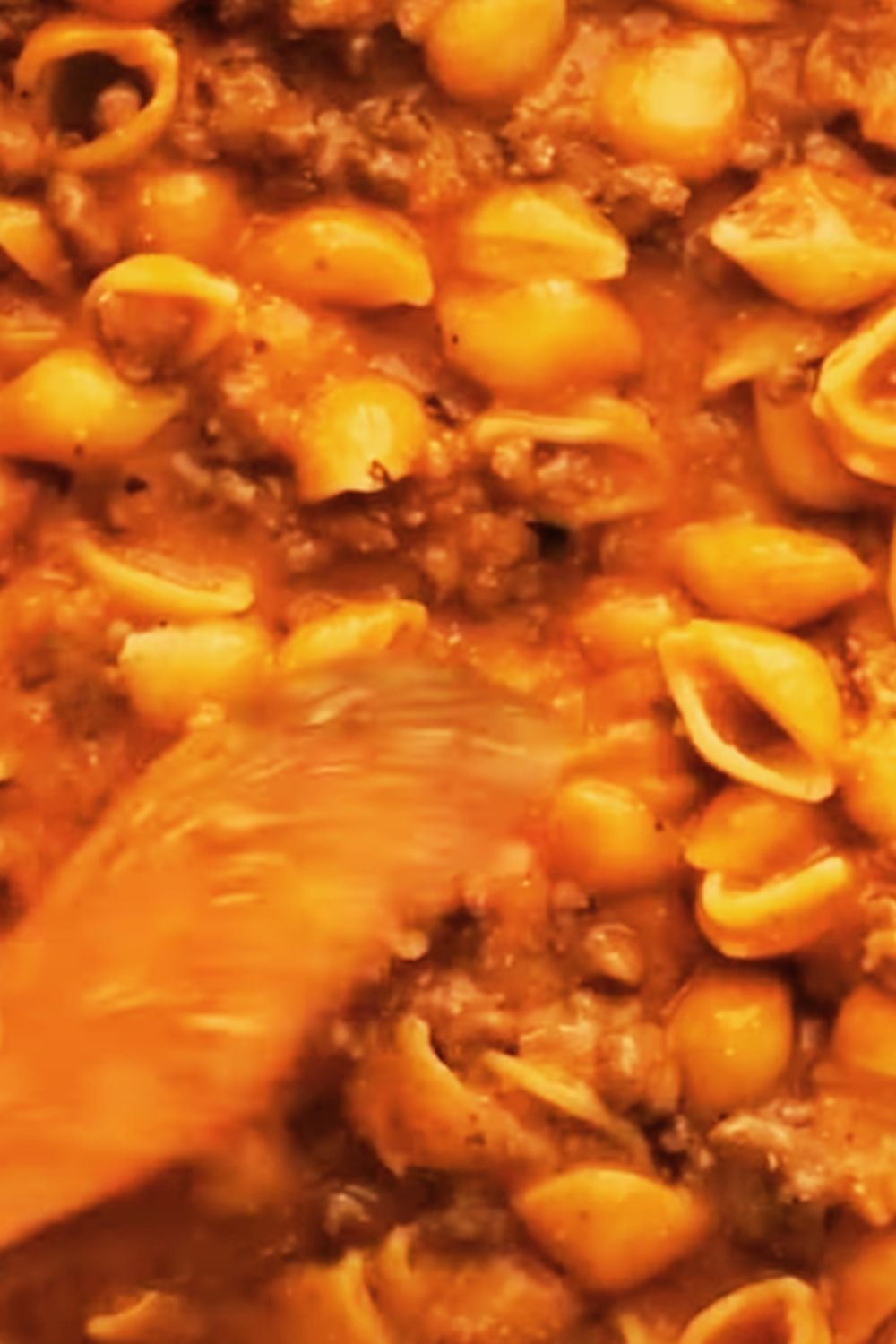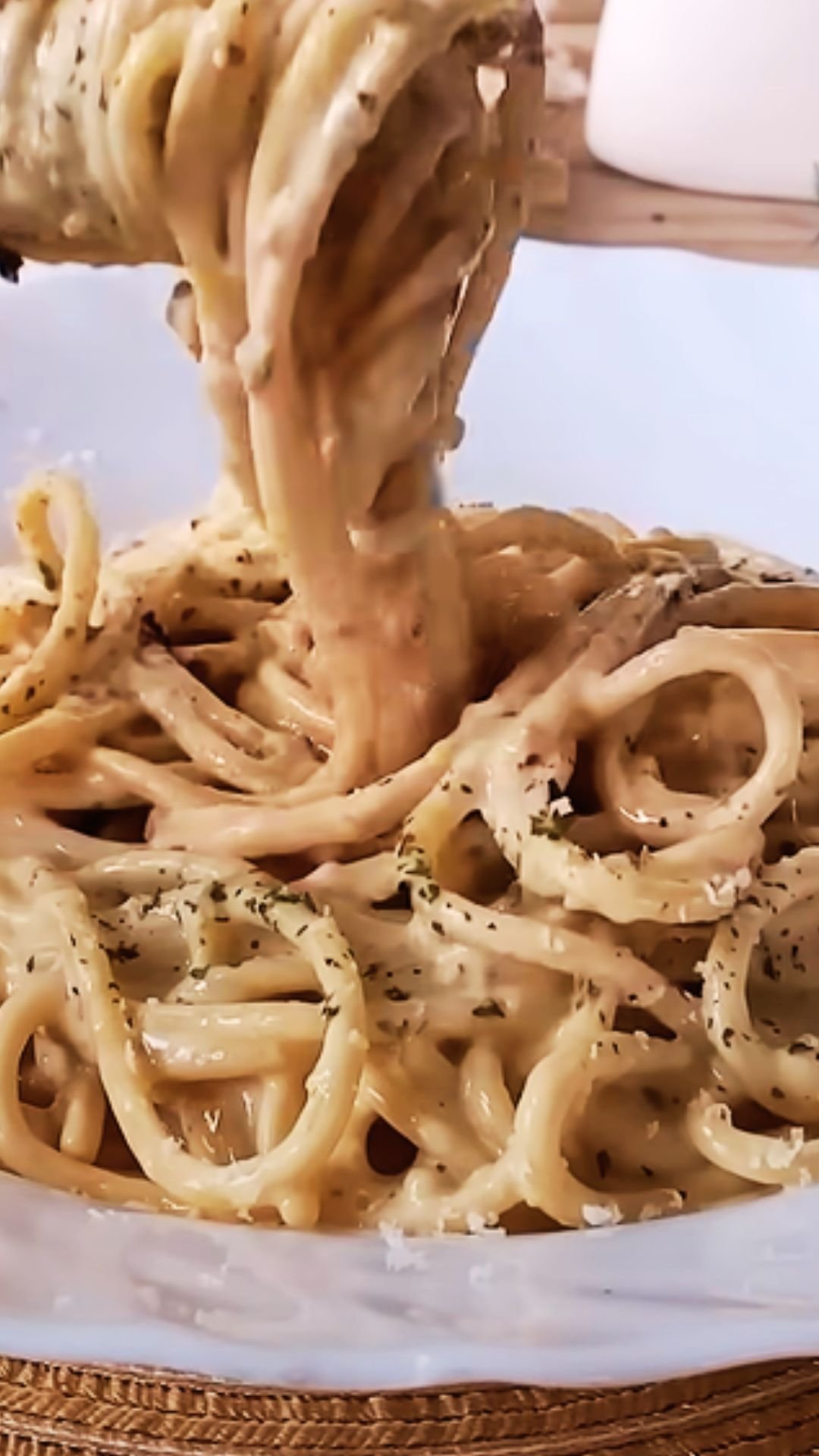When I first encountered Yum Woon Sen at a bustling street food stall in Bangkok, I was immediately captivated by its vibrant presentation and the incredible balance of flavors dancing on my palate. This isn’t just another noodle salad – it’s a masterpiece of Thai culinary artistry that brings together the perfect harmony of sweet, sour, salty, and spicy elements that define authentic Thai cuisine.
Yum Woon Sen, literally translating to “mixed glass noodles,” represents everything I love about Thai cooking: fresh ingredients, bold flavors, and a dish that’s both satisfying and refreshing. Whether you’re new to Thai cuisine or a seasoned enthusiast, this glass noodle salad will become your go-to recipe for hot summer days and when you crave something light yet fulfilling.
What Makes Yum Woon Sen Special
The beauty of Yum Woon Sen lies in its simplicity and the quality of its ingredients. Glass noodle salad is a staple dish in any Thai home with bright fresh flavours and really easy to make! What sets this dish apart from other Asian noodle salads is its unique texture contrast – the translucent, chewy glass noodles provide the perfect backdrop for crisp vegetables, tender proteins, and aromatic herbs.
I’ve discovered that the magic happens in the dressing, which combines the fundamental flavors of Thai cuisine. The lime juice provides the essential sourness, fish sauce adds depth and umami, while palm sugar balances everything with its subtle sweetness. Thai chilies bring the heat that makes your taste buds sing, creating a symphony of flavors that’s both complex and refreshing.
Understanding Glass Noodles: The Star Ingredient
Glass Noodles (Woon Sen) : Translucent noodles made from mung bean starch, also known as cellophane noodles or bean thread noodles. They become clear and slightly chewy when cooked.
Mung Bean Starch : The primary ingredient in glass noodles, derived from ground mung beans. This starch gives the noodles their characteristic transparency and texture.
Cellophane Noodles : Another name for glass noodles, referring to their clear, glass-like appearance after cooking.
Glass noodles are naturally gluten-free, making this dish accessible to those with gluten sensitivities. They’re also incredibly versatile – they absorb flavors beautifully while maintaining their unique texture that’s both tender and slightly chewy.
Essential Ingredients for Authentic Yum Woon Sen
Creating authentic Yum Woon Sen requires specific ingredients that contribute to its distinctive flavor profile. Here’s what you’ll need:
For the Salad Base:
- 4 oz dried glass noodles (mung bean noodles)
- 8 oz medium shrimp, peeled and deveined
- 4 oz ground pork
- 2 medium tomatoes, cut into wedges
- 1 medium cucumber, julienned
- 2 stalks celery, thinly sliced
- 1 medium red onion, thinly sliced
- 2 green onions, chopped
- 1/4 cup roasted peanuts, crushed
- Fresh cilantro leaves
- Fresh mint leaves
- Thai bird’s eye chilies
For the Dressing:
- 3 tablespoons fresh lime juice
- 2 tablespoons fish sauce
- 1 tablespoon palm sugar (or brown sugar)
- 2 cloves garlic, minced
- 2-3 Thai chilies, minced
Step-by-Step Preparation Guide
Preparing the Glass Noodles
The key to perfect glass noodles is not to overcook them. I soak them in hot water for about 5-7 minutes until they’re tender but still have a slight bite. Overcooked glass noodles become mushy and lose their appealing texture.
- Bring a large pot of water to boil
- Remove from heat and add glass noodles
- Let them soak for 5-7 minutes
- Drain and rinse with cold water to stop cooking
- Cut into manageable lengths (about 4-6 inches)
Cooking the Proteins
This is traditional Thai technique of shallow boiling the minced meat in water seasoned with fish sauce. Less water is used so that the fish sauce is not diluted. This technique ensures the meat stays tender and absorbs maximum flavor.
For the ground pork:
- Heat a small amount of water in a pan
- Add 1 tablespoon fish sauce to the water
- Add ground pork and cook until done
- Drain and set aside to cool
For the shrimp:
- Boil shrimp in salted water for 2-3 minutes
- Remove and plunge into ice water
- Drain and set aside
Making the Perfect Dressing
The dressing is where the magic happens. I always taste and adjust as I go, aiming for the perfect balance of sweet, sour, salty, and spicy.
- Pound garlic and chilies in a mortar and pestle
- Add palm sugar and continue pounding until dissolved
- Add fish sauce and lime juice
- Mix well and taste for balance

Assembly and Serving
Assembling Yum Woon Sen is like creating a beautiful, edible artwork. The key is to maintain the vibrant colors and textures of each ingredient while ensuring the dressing coats everything evenly.
- Combine glass noodles, cooked proteins, and vegetables in a large bowl
- Pour dressing over the mixture
- Toss gently but thoroughly
- Garnish with fresh herbs, peanuts, and extra chilies
- Serve immediately at room temperature
Nutritional Benefits and Health Aspects
Yum Woon Sen isn’t just delicious – it’s also packed with nutritional benefits that make it a guilt-free indulgence. The dish is naturally low in calories while being rich in protein, vitamins, and minerals.
| Nutrient | Amount per Serving | % Daily Value |
|---|---|---|
| Calories | 285 | 14% |
| Protein | 22g | 44% |
| Carbohydrates | 32g | 11% |
| Fat | 8g | 12% |
| Fiber | 3g | 12% |
| Vitamin C | 35mg | 39% |
| Iron | 2.5mg | 14% |
| Potassium | 450mg | 13% |
The glass noodles provide complex carbohydrates for sustained energy, while the shrimp and pork offer high-quality protein. The abundance of fresh vegetables and herbs contributes essential vitamins, minerals, and antioxidants.
Variations and Adaptations
One of the things I love most about Yum Woon Sen is its versatility. While the traditional version includes shrimp and pork, I’ve experimented with numerous variations that cater to different dietary preferences and available ingredients.
Vegetarian Version
Replace the proteins with:
- Fried tofu cubes
- Mushrooms (shiitake or oyster)
- Extra vegetables like bean sprouts
- Use soy sauce instead of fish sauce
Seafood Lovers’ Version
- Mixed seafood (squid, mussels, crab)
- Grilled fish pieces
- Scallops
Spice Level Variations
- Mild: Use only 1 chili or omit entirely
- Medium: 2-3 chilies as in traditional recipe
- Thai Hot: 5-6 chilies plus extra in dressing
Regional Variations Across Thailand
During my travels through Thailand, I’ve encountered fascinating regional variations of Yum Woon Sen that reflect local ingredients and preferences.
| Region | Distinctive Features | Special Ingredients |
|---|---|---|
| Bangkok | Classic preparation | Standard ingredients |
| Northern (Chiang Mai) | Milder, more herbs | Local herbs, less spicy |
| Southern | Spicier, more seafood | Fresh seafood, extra chilies |
| Isaan (Northeast) | Fermented additions | Fermented fish sauce, local vegetables |
Each region brings its own twist while maintaining the core identity of this beloved dish.
Storage and Meal Prep Tips
Yum Woon Sen is best enjoyed fresh, but with proper storage techniques, you can prepare components ahead of time for quick assembly.
Storage Guidelines:
- Dressed salad: Consume within 2 hours at room temperature
- Separated components: Store in refrigerator for up to 2 days
- Dressing: Keeps for up to 1 week in refrigerator
- Cooked proteins: Use within 3 days when refrigerated
Meal Prep Strategy:
- Cook proteins and store separately
- Prepare vegetables and store in airtight containers
- Make dressing in advance
- Cook noodles fresh for best texture
- Assemble just before serving
Common Mistakes to Avoid
Through my years of making and teaching Yum Woon Sen, I’ve identified several common mistakes that can compromise the dish’s quality:
Overcooking the Glass Noodles: This is the most frequent error. Overcooked noodles become mushy and lose their appealing texture. Always test for doneness by tasting.
Imbalanced Dressing: The dressing should achieve perfect harmony between sweet, sour, salty, and spicy. Taste and adjust constantly.
Using the Wrong Noodles: Not all “glass noodles” are created equal. Ensure you’re using mung bean noodles for authentic texture and flavor.
Assembling Too Early: The salad should be tossed just before serving to maintain the crisp texture of vegetables and prevent the noodles from absorbing too much dressing.
Serving Suggestions and Pairings
Yum Woon Sen shines as both a standalone meal and as part of a larger Thai feast. Here are my favorite serving suggestions:
As a Main Course:
- Serve with jasmine rice for a more filling meal
- Pair with Thai iced tea or fresh coconut water
- Add crispy rice crackers for textural contrast
As Part of a Thai Feast:
- Complement with Tom Yum soup
- Serve alongside Pad Thai or other stir-fried dishes
- Include fresh fruit for dessert (mango, pineapple)
Light Lunch Options:
- Serve in smaller portions with spring rolls
- Pair with fresh fruit salad
- Accompany with herbal tea
Cultural Significance and History
Yum Woon Sen represents more than just a delicious meal – it’s a window into Thai culture and culinary philosophy. The dish embodies the Thai principle of balancing flavors, textures, and colors in every meal.
Historically, glass noodles were introduced to Thailand through Chinese immigrants, but Thai cooks adapted the ingredient to create something uniquely their own. The addition of lime juice, fish sauce, and fresh herbs transformed a simple Chinese noodle into a distinctly Thai creation.
The communal aspect of sharing Yum Woon Sen also reflects Thai dining culture, where meals are meant to be shared among family and friends, fostering connection and community.
Troubleshooting Guide
Even experienced cooks sometimes encounter challenges when making Yum Woon Sen. Here are solutions to common issues:
| Problem | Cause | Solution |
|---|---|---|
| Mushy noodles | Overcooked | Reduce soaking time, use cold water rinse |
| Too salty | Excess fish sauce | Add more lime juice and palm sugar |
| Lacks flavor | Insufficient dressing | Increase dressing components proportionally |
| Too spicy | Too many chilies | Add more vegetables and sugar |
| Watery texture | Wet ingredients | Pat dry all vegetables before mixing |
Shopping Guide for Authentic Ingredients
Finding authentic ingredients can be challenging, but here’s my guide to sourcing the best components:
Where to Shop:
- Asian grocery stores (best selection)
- Online retailers (convenient but check freshness)
- Some mainstream supermarkets (limited selection)
What to Look For:
- Glass noodles: Look for “mung bean noodles” on the label
- Fish sauce: Choose brands from Thailand or Vietnam
- Palm sugar: Sold in blocks or granulated form
- Thai chilies: Small, extremely hot peppers
Substitutions When Needed:
- Palm sugar: Brown sugar or coconut sugar
- Fish sauce: Soy sauce (for vegetarian version)
- Thai chilies: Serrano or jalapeño peppers
- Lime juice: Fresh lemon juice (less authentic but workable)
Q&A Section
Q: Can I make Yum Woon Sen ahead of time? I recommend preparing the components separately and assembling just before serving. The dressed salad is best consumed within 2 hours to maintain optimal texture and prevent the vegetables from becoming soggy.
Q: What’s the best way to adjust the spice level? Start with fewer chilies and gradually increase to your preference. Remember that the heat will intensify as the salad sits, so err on the side of caution initially.
Q: Can I substitute the glass noodles with regular noodles? While you can use other noodles, glass noodles are essential for authentic Yum Woon Sen. Their unique texture and ability to absorb flavors make them irreplaceable in this dish.
Q: How do I know when the glass noodles are properly cooked? Perfect glass noodles should be translucent, tender, and slightly chewy. They shouldn’t be mushy or have any hard centers. Taste-test during soaking to achieve the right texture.
Q: Is Yum Woon Sen suitable for meal prep? Yes, but with modifications. Store components separately and assemble fresh portions as needed. The cooked proteins and vegetables can be prepped 2-3 days in advance.
Q: What’s the difference between glass noodles and rice noodles? Glass noodles are made from mung bean starch and become transparent when cooked, while rice noodles are made from rice flour and remain white. The textures are completely different.
Q: Can I freeze Yum Woon Sen? I don’t recommend freezing this salad as the vegetables will lose their crispness and the noodles will become mushy upon thawing. This dish is best enjoyed fresh.
Q: How can I make the dish less fishy-tasting? Use less fish sauce and balance with more lime juice and palm sugar. For a completely fish-free version, substitute with soy sauce, though this changes the authentic flavor profile.
Q: What vegetables can I substitute or add? You can add bean sprouts, carrots, bell peppers, or cabbage. The key is maintaining a balance of textures and colors while ensuring vegetables stay crisp.
Q: Why is my dressing not sticking to the noodles? This usually happens when the noodles are too wet or the dressing is too thin. Pat the noodles dry after cooking and ensure your dressing has the right consistency by balancing the liquid ingredients.
Yum Woon Sen is more than just a recipe – it’s an invitation to explore the vibrant world of Thai cuisine. Every time I prepare this dish, I’m reminded of the incredible depth and complexity that can be achieved with simple, fresh ingredients and the right techniques. Whether you’re cooking for family, friends, or just treating yourself to something special, this Thai glass noodle salad will transport you to the bustling streets of Thailand with every bite.
The beauty of this dish lies not just in its flavors, but in its ability to bring people together around the table, sharing stories and creating memories over a bowl of perfectly balanced, refreshing noodles. So gather your ingredients, invite some friends over, and prepare to fall in love with one of Thailand’s most beloved salads.


